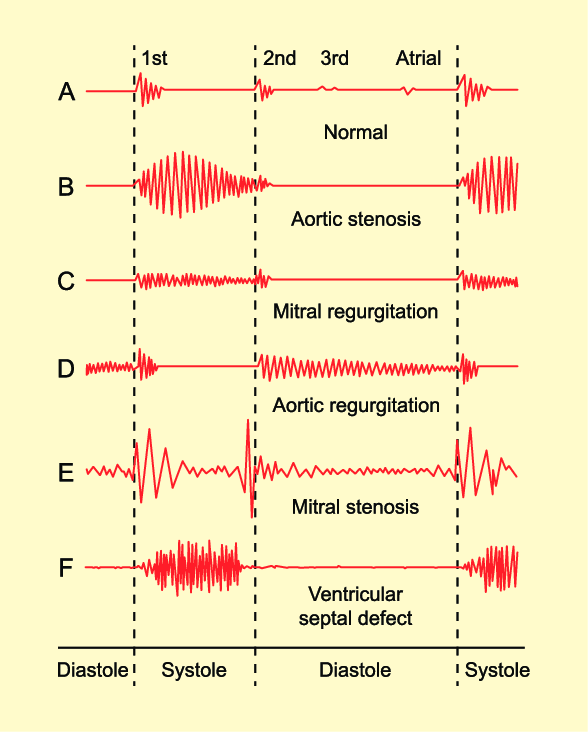The nurse is auscultating heart sounds on a client and hears an extra sound late in diastole, just before the S1. How should the nurse document this finding?
The third heart sound (S3)
A friction rub
The fourth heart sound (S4)
A split second heart sound S2
The Correct Answer is A
A. The third heart sound (S3):
The third heart sound (S3) is an abnormal heart sound that occurs during early diastole, immediately after S2 (the second heart sound). It is caused by the rapid filling of the ventricles and is often associated with conditions like heart failure. In heart failure, the ventricles become stiff, causing vibrations that produce the S3 sound.
B. A friction rub:
A friction rub is a high-pitched, scratchy sound heard during both systole and diastole. It is caused by the rubbing together of inflamed pericardial layers (pericarditis) and is usually heard best at the left lower sternal border. Friction rubs can indicate pericardial inflammation and are often heard in conditions such as pericarditis or after a myocardial infarction.
C. The fourth heart sound (S4):
The fourth heart sound (S4) occurs late in diastole, just before S1, and is caused by atrial contraction. It is associated with increased resistance to ventricular filling, often due to conditions like hypertension or aortic stenosis. The S4 sound is heard as a low-pitched "atrial gallop."
D. A split second heart sound S2:
The second heart sound (S2) represents the closure of the aortic and pulmonic valves. Normally, S2 has two components: A2 (aortic valve closure) and P2 (pulmonic valve closure). A split S2 occurs when A2 and P2 do not close simultaneously. A physiological split S2 is common during inspiration and occurs due to delayed closure of the pulmonic valve. An abnormal or fixed split S2 can indicate underlying heart conditions such as atrial septal defect (ASD) or right bundle branch block (RBBB).

Nursing Test Bank
Naxlex Comprehensive Predictor Exams
Related Questions
Correct Answer is A
Explanation
A. Maxillary sinusitis:
Explanation: The client's symptoms of facial pain, fever, malaise, swollen turbinates, purulent nasal discharge, and dull, throbbing pain in the cheeks and teeth on the right side, especially when palpated, are indicative of maxillary sinusitis. Maxillary sinusitis refers to the inflammation of the maxillary sinuses, which are located in the cheek area. The symptoms described align with a bacterial infection in this sinus.
B. Nasal polyps:
Explanation: Nasal polyps are soft, noncancerous growths on the lining of the nasal passages or sinuses. While they can cause nasal congestion and a runny nose, they do not typically present with the specific symptoms mentioned in the scenario, such as facial pain, fever, and purulent discharge.
C. Frontal sinusitis:
Explanation: Frontal sinusitis involves inflammation of the frontal sinuses located in the forehead area. Symptoms may include forehead pain, headache, and nasal discharge. However, the described symptoms in the scenario (dull, throbbing pain in the cheeks and teeth on the right side) are more characteristic of maxillary sinusitis.
D. Posterior epistaxis:
Explanation: Posterior epistaxis refers to a nosebleed that originates from the back of the nose, often due to bleeding from the sphenopalatine artery. While nosebleeds can cause blood drainage into the throat and result in a metallic taste, the other symptoms described in the scenario, such as facial pain, fever, and purulent discharge, are not indicative of posterior epistaxis.
Correct Answer is D
Explanation
A. Perform the confrontation test:
The confrontation test is a basic visual field screening test. It assesses the peripheral vision by having the patient cover one eye and the examiner covers the opposite eye. The patient and the examiner then bring their fingers into the visual field from the periphery, and the patient indicates when they see the fingers.
B. Ask the patient to read the print on a handheld Jaeger card:
Jaeger cards are used for near vision testing. The patient reads progressively smaller print to assess their near vision acuity.
C. Determine the patient's ability to read newsprint at a distance of 12 to 14 inches:
This method assesses near vision. It is often used informally in clinical settings, where the patient is asked to read a newspaper or similar print at a comfortable reading distance.
D. Use the Snellen chart positioned 20 feet away from the patient:
The Snellen chart is a standardized chart used for visual acuity testing. It is placed 20 feet away from the patient, and the patient is asked to read the letters or symbols on the chart with one eye covered at a time.
Whether you are a student looking to ace your exams or a practicing nurse seeking to enhance your expertise , our nursing education contents will empower you with the confidence and competence to make a difference in the lives of patients and become a respected leader in the healthcare field.
Visit Naxlex, invest in your future and unlock endless possibilities with our unparalleled nursing education contents today
Report Wrong Answer on the Current Question
Do you disagree with the answer? If yes, what is your expected answer? Explain.
Kindly be descriptive with the issue you are facing.
